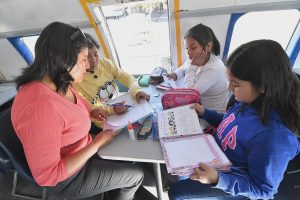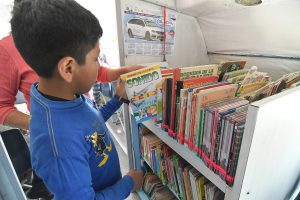
By Gina Baldivieso
Cochabamba, Bolivia, Jul 30 (EFE).- The imagination and creativity of children’s literature takes flight every day in an old airplane made into a library that entices Bolivian youngsters to become avid readers.
The teeming Wayrak-asa district on the south side of the central Bolivian city of Cochabamba has landed Biblioavion (Library Plane), an imposing Convair T-29B aircraft dating back to 1953.
On the outside it looks like any ordinary plane, though all the pictures of books painted on its fuselage along with the slogan “La lectura es mi locura” (I’m crazy about reading) give an idea about what is to be found inside.
Tables, chairs and bookcases full of stories, educational books and kiddies’ novels create an atmosphere that encourages children and teens to read in this one-of-a-kind library, which is part of the network of enterprises that form the Simon I. Patiño Center.
“The youngsters feel like they’re flying in an airplane, through their reading, obviously,” the director of the Library Chain of the Simon I. Patiño Center, Juan Carlos Ayala, told EFE.
With a history of converting railroad cars into libraries, the chain sought to go for “an alternative space” to promote reading.
An airplane was picked because it would be “something exciting.” The one chosen belonged to the Bolivian air force in La Paz and was no longer in use, according to Ayala.
The center negotiated the purchase of the plane and trucked its dismantled parts to Cochabamba, where it was reassembled in the Wayrak-asa district.
Biblioavion’s arrival in the neighborhood meant a sudden huge improvement to what had been an abandoned vacant lot, and which suddenly became a children’s park featuring a real airplane.
Seventeen years have gone by since the youngsters’ library was installed, “almost a lifetime,” above all for the first passengers on the Biblioavion, many of them now practicing professionals, the library chain’s director said.
With a capacity for 30 children at a time, the Biblioavion is open every afternoon from Tuesday through Saturday for minors age 5 and older for reading motivation, comprehension strategies and help with their school studies, the manager of this library, Julieta Pardo, told EFE.
The challenge for libraries to attract readers has become ever greater as technologies and the use of mobile phones have advanced, Pardo admitted.
To deal with that challenge, the library decided to focus on developing children’s creativity with activities complementary to reading, such as dramatizations, puppet shows, origami and making filigree ornaments.

“We look to all kinds of creative techniques so the kids see this is not just about reading, but also about having fun,” said Pardo, who has been working at the Biblioavion for 12 years.
The library also offers school support through its reading clubs, which meet once a week with each made up of some 20 children, according the manager.
Sundays are reserved for families, and on that day the library offers activities with no age restrictions, even admitting preschoolers.
“Biblioavion has books for the daddies to read, or share the reading with their youngsters and perhaps at the same time play a series of educational games with them,” Pardo said.
The library has some 60 regular users who attend its weekly workshops and reading clubs, with some 30 to 40 people showing up on Sundays.
“This is no place for tourism – people don’t come in, look around and leave – but rather come to stay and make use of the reading material and activities made available to them,” the manager said.
For that reason on Sundays, when there is the greatest number of visitors, families arrive in groups and leave “once they have finished to their satisfaction,” she said.
The reading material is varied and includes some 1,500 texts by authors of different nationalities, such as the Argentines Gustavo Roldan and Ricardo Mariño and the Englishman Anthony Browne.
Most in demand are the “album books,” a format in which text and image are inseparable.
Not long ago the Biblioavion was honored as the “Library of the Year Nationwide” by Bolivia’s National School of Information Science.
